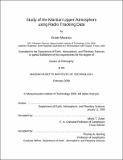Study of the Martian upper atmosphere using radio tracking data
Author(s)
Mazarico, Erwan Matías Alexandre, 1981-
DownloadFull printable version (4.057Mb)
Other Contributors
Massachusetts Institute of Technology. Dept. of Earth, Atmospheric, and Planetary Sciences.
Advisor
Maria T. Zuber.
Terms of use
Metadata
Show full item recordAbstract
Since the first in situ observations of the Martian atmosphere were made by the twin Viking landers, we have learned considerably more about its composition, dynamics and variability. Not only did the new data on global atmospheric densities generate opportunities to understand the atmospheric composition of early Mars and supply constraints at the upper limit of General Circulation Models, it is critical for the design and planning of future exploration missions. We can complement the successes of remote sensing and accelerometer investigations by using radio tracking data that have not been studied from an atmospheric science perspective, or are available for the first time. Due to the very low density of the higher layers atmosphere, the estimation of the drag acceleration using Precision Orbit Determination is a challenge. We developed new numerical models of the non-conservative forces acting on the spacecraft. In particular, the spacecraft crosssectional area is calculated using improved spacecraft macro-models which include interplate shadowing. These improvements in the force modeling enable a more robust estimation of the atmospheric density. The density structure from the middle atmosphere up to the exosphere is studied using radio tracking data from the Mars Odyssey and the Mars Reconnaissance Orbiter spacecraft. Measurements in the Martian middle atmosphere, near 100 -- 110 km, are obtained from the aerobraking phase of the Mars Odyssey spacecraft; we obtain periapsis density estimates consistent with the Accelerometer Team, and estimate scale heights representative of the drag environment from an operational point of view. The orbit of Mars Odyssey during its mapping and extended phases allows us to probe very high in the exosphere, near 400 km altitude. In the retrieved density time series, we observe some of the features of solar forcing and seasonal cycle predicted by different atmospheric models. (cont.) The most recent radio tracking data, from the Mars Reconnaissance Orbiter mapping mission, enables a monitoring of densities near 250 -- 300 km at higher temporal and spatial resolutions, allowing a more detailed study than previously possible.
Description
Thesis (Ph. D.)--Massachusetts Institute of Technology, Dept. of Earth, Atmospheric, and Planetary Sciences, 2008. This electronic version was submitted by the student author. The certified thesis is available in the Institute Archives and Special Collections. Includes bibliographical references.
Date issued
2008Department
Massachusetts Institute of Technology. Department of Earth, Atmospheric, and Planetary SciencesPublisher
Massachusetts Institute of Technology
Keywords
Earth, Atmospheric, and Planetary Sciences.